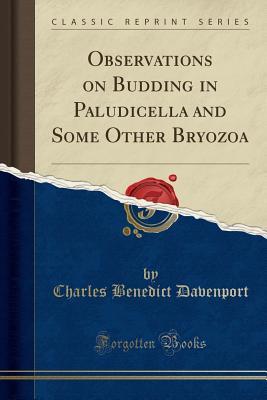Read Online Observations on Budding in Paludicella and Some Other Bryozoa (Classic Reprint) - Charles Benedict Davenport file in ePub
Related searches:
Observations on Budding in Paludicella and Some Other Bryozoa
Observations on Budding in Paludicella and Some Other Bryozoa (Classic Reprint)
OBSERVATIONS ON BUDDING IN PALUDICELLA AND SOME
Organogenesis during budding and lophophoral morphology of
Observations On Budding In Paludicella And Some Other Bryozoa
Observations on budding in Paludicella and some other Bryozoa
Sources and links - Bryozoans.nl
Budding Cells - Fungi, Plants, Bacteria, Yeast, and Hydra
Charles Davenport : definition of Charles Davenport and
Phyla Ectoprocta and Entoprocta (Bryozoans) - ScienceDirect
Autoradiographic study of feeding and the colonial transport
Observations on budding in paludicella and some other bryozoa.
Articulata often has a typical chitine shine also found on beetle shields. Articulata, as colonies are small and therefore easily overlooked. Articulata is more easily found as colonies have grown bigger.
Observations on budding in paludicella and some other bryozoa (1891) on urnatella gracilis (1896) experimental morphology (1897–99) statistical methods, with special references to biological variation (1899; second edition, 1904) introduction to zoölogy, with gertrude crotty davenport (1900) 1906.
Observations on budding in paludicella and some other bryozoa (1891); on urnatella gracilis (1896); experimental morphology (1897–99); statistical methods.
12 jul 2018 paludicella articulata, represented the class gymnolaemata. Davenport cb ( 1891) observations on budding in paludicella and some other.
Observations on budding in paludicella and some other bryozoa by charles benedict davenport, 9781179563992, available at book depository with free delivery worldwide.
Davenport cb (1891) observations on budding in paludicella and some other bryozoa.
10 dec 2014 therefore, the ctenostome paludicella articulata was analyzed in order to davenport cb: observations on budding in paludicella and some.
Preliminary observations have shown a small lumen within the cerebral ganglion of the ctenostome paludicella articulata. Ctenostome-grade ectoprocts are of phylogenetic relevance since they are considered to have retained ancestral ectoproct features.
Detailed investigations on the polypide development during the budding process of ctenostome bryozoans were only carried out by daven- port [10] for paludicella articulata.
Observations on budding in paludicella and some other bryozoa (1891)� on urnatella gracilis (1896)� experimental morphology (1897–99)�.
Observations on budding in paludicella and some other bryozoa (1891) on urnatella gracilis (1893) experimental morphology (1897-99) statistical methods, with special references to biological variation (1899, 2nd ed 1904).
In paludicella (ehrenberg, 1831), the cilia of the ascending arm of the stomach twirl the contents in a rapidly rotating cord. In hislopia annandale, 1907, the mixing cilia are mostly in the descending arm of the stomach in a region between the caecum and a muscular chamber that alternately compresses particles and feeds them into the caecum.
Future observations of live animals are required and should clarify which pathways might be at work in various ctenostomes and whether details in polypide anatomy show distinct differences. Winston 1977 ) that have a typical lophophoral anus were considered to follow defecation.
Transitory basal muscles, present in this species are also found in budding stages of paludicella articulata (fig. 11) in which young buds possess a transitory median transverse muscle close to the pore complex (fig. 11) that is reduced during zooidal ontogeny� this transitory muscle was considered to be homologous to the transverse stolonal.
Budding is a type of asexual reproduction where the new organism (offspring) and asexual modes of reproduction have been observed in different species.
1891-1900 observations on budding in paludicella and some other bryozoa (1891) on urnatella gracilis (1896) experimental morphology (1897–99).
Schizoporella unicornis floridana osburn from maryland and new jersey, usa, produces two types of autozoids: (1) “primogenial” zoids, arranged in the brick-like “quincunx” pattern usual among cheilostomes; (2) “adventitious”, or frontally-budded zoids. Adventitious zoids are produced by expansion of the epitheca of primogenial or other adventitious zoids.
Observations on budding in paludicella and some other bryozoa [davenport, charles benedict] on amazon. Observations on budding in paludicella and some other bryozoa.
Observations on budding in paludicella and some other bryozoa (1891) on urnatella gracilis (1893) experimental morphology (1897-99) statistical methods, with special references to biological variation (1899, 2nd ed 1904) introduction to zoology, with gertrude crotty davenport (1900).
18 apr 2011 developmental processes during the budding of bryozoans bryozoans were only carried out by davenport [10] for paludicella articulata. More recent observations [17, 18] found both layers of the body wall directly.
Observations on budding in paludicella and some other bryozoa (1891) on urnatella gracilis (1896) experimental morphology (1897–99) statistical methods, with special references to biological variation (1899; second edition, 1904).
Observations on budding in paludicella and some other bryozoa, by 1866-1944.
Davenport, charles benedict, 1866-1944: observations on budding in paludicella and some other bryozoa, (page images at hathitrust) davenport, charles benedict, 1866-1944: on the acclimatization of organisms to high temperatures.
Autore: charles benedict davenport; categoria: lingua straniera - inglese; lunghezza: 162 pagine; anno: 1891.
Davenport cb: observations on budding in paludicella and some other bryozoa.

Post Your Comments: